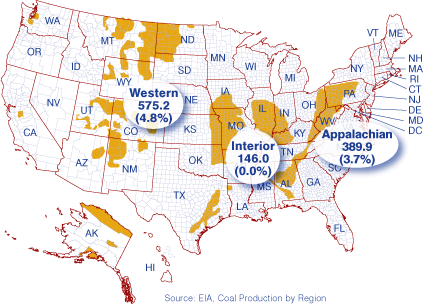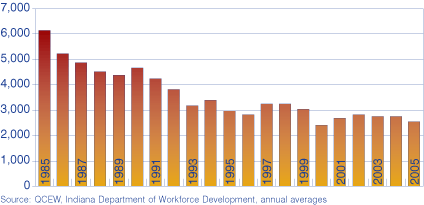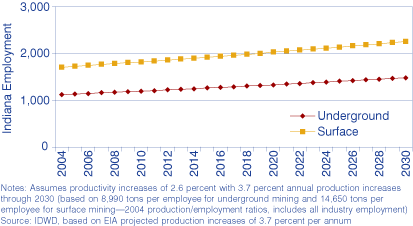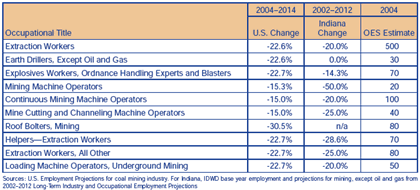Coal Mining in Indiana: All Fired Up or In the Pits?
There is unquestionably coal in Indiana, along with the corn, soybeans and racetrack. In fact, Indiana's recoverable coal reserves are estimated at 4.3 billion short tons, based on estimates from the federal Energy Information Administration (EIA) and industry analysts. Reserves are estimated to provide around a 120-year supply using 2004 coal production. Southwestern Indiana sits astride the eastern interior coal field, which stretches from Kentucky into northern Illinois (see Figure 1).
Figure 1: Production in Millions of Short Tons—Change from 2003 Production

Indiana's coal is bituminous, or high-sulfur coal, and much of it is close enough to the surface that the state's mining industry has been stripping it off for decades without resorting to underground mining. In 2004, Indiana's surface mines produced just over 25 million short tons and underground mines produced about 10 million short tons (a short ton equals 2,000 pounds). Underground mining in Indiana is growing, however, as 90 percent of Indiana's remaining coal will be accessed by underground mining, according to the EIA's summary of reported reserves. The 18 current underground production units, or sections, are expected to double within the next few years; nine new sections are expected to open in the next 12 months, based on industry reports to the Vincennes office of the Mine Safety and Health Administration.
Indiana's coal has a high sulfur content (which has a negative impact on air pollution standards), so it has been handicapped by competition from lower-sulfur, surface-mined coal from regions such as Wyoming's Power River Basin. Emissions control regulations in recent years, however, have resulted in wider deployment of smokestack “scrubbers,” which allow use of high-sulfur coal without increasing harmful emissions. In addition, emerging technologies such as coal-to-liquids offer the promise of cleaner-burning fuels generated from Indiana's coal. Industry officials believe that Indiana coal mining employment will grow significantly over the next few years and have expressed concerns about shortages of skilled workers—despite historical trends which depict coal mining as a declining industry (see Figure 2).
Figure 2: Indiana's Coal Mining Employment, 1985 to 2005

Indiana's current employment in the coal mining sector—averaging 2,600 over the first six months of 2005—is close to its low of 2,400 workers in 2000. The EIA estimates 2004 average employment at 1,708 for Indiana's surface coal mines, and 1,122 for our underground mines. Coal mining employs slightly less than 1 percent of Indiana's total establishment employment. Over 90 percent of those employees are concentrated in southwest Indiana's Economic Growth Regions 8 (including Bloomington) and 11 (including Evansville). In neither of these regions does employment in coal mining exceed 1 percent of establishment employment.
While employment data for coal mining include most employees at mining operations, Indiana employment in jobs classified as extractive occupations is projected to decline over the next few years, closely following the national projections for these occupations. Projected employment trends downward by 15 percent through 2012 for the mining (excluding oil and gas) industry. Industry and occupational employment projections depend heavily on historical employment trends and might not adequately reflect planned or anticipated shifts in production and energy consumption patterns (see Table 1).
Table 1: Employment Projections for Extractive Occupations
The mining industry, like the manufacturing sector, is faced with an aging workforce. Local Employment Dynamics data for the industry, extracted for fourth quarter 2004, estimate 31 percent of Indiana's coal mining workforce was between the ages of 45 and 54, compared to 47 percent of those employed in Indiana's steel mills and 27 percent for manufacturing overall. For the 55-64 age group, the rates were 12 percent (coal), 20 percent (steel) and 14 percent (manufacturing); attrition due to retirement is potentially an issue for this industry sector, but should be in line with that for other production-type occupations. Key job skills for the extractive and some common manufacturing production jobs such as welders and cutters, brazers, solderers and production worker helpers have significant overlap. In Table 2, red bullets signify key skills common to both occupational groupings.
Table 2: Key Skills
This overlap in key skills suggests transferability of job skills and experience between production and extractive occupations that could allow workers to move in either direction based on labor demand.
The EIA's long-term forecasts predict 3.7 percent per annum increases in the production of interior, high-sulfur coal such as Indiana's through 2030, compared to a 1.9 percent increase per year for the industry overall. When combined with projected productivity increases of 2.6 percent per annum, net employment would grow at 1.1 percent (see Figure 3). This figure assumes that coal production per employee remains constant and includes all industry employment. These projections, based on inferred production increases for Indiana coal rather than historical employment patterns, run counter to our standard long-term employment projections. Industry employment growth of 1.1 percent a year also contradicts current projections for the U.S. economy, but would be more consistent with reported planned expansions, specifically of underground mining.
Figure 3: Projected Coal Mining Employment Based on EIA Production Forecasts

Several factors will influence the future of Indiana's coal mining sector, including continuation or expansion of current or projected trends:
- Increases to coal production for the eastern interior coal field.
- Cost competitiveness of coal compared to other fuel sources for electricity generation and expanded deployment of smokestack scrubbing technology.
- Expansion and maturation of new technologies such as coal-to-liquids, which transform the very nature of the fuel.
- Competition from lower-sulfur, surface-mined western coal, for which the EIA projects increased market share, even in eastern states.
Indiana coal and coal mining will be with us for a long time, and while employment projections for the industry based on differing models and various assumptions may yield different results, we will certainly track that employment as it occurs and report back.
Sources
- Energy Information Administration website (www.eia.gov/), Coal Resources, Reserves and Mine Sizes, Indiana, Coal Production and Number of Mines by State and Mine Type, and Annual Energy Outlook 2006, including supplemental tables
- Indiana Coal Council, Mr. Nat Noland
- Mine Safety and Health Administration, Vincennes Office, Mr. Bryan Sargeant
Vicki D. Seegert, Research & Analysis
Indiana Department
Workforce Development


